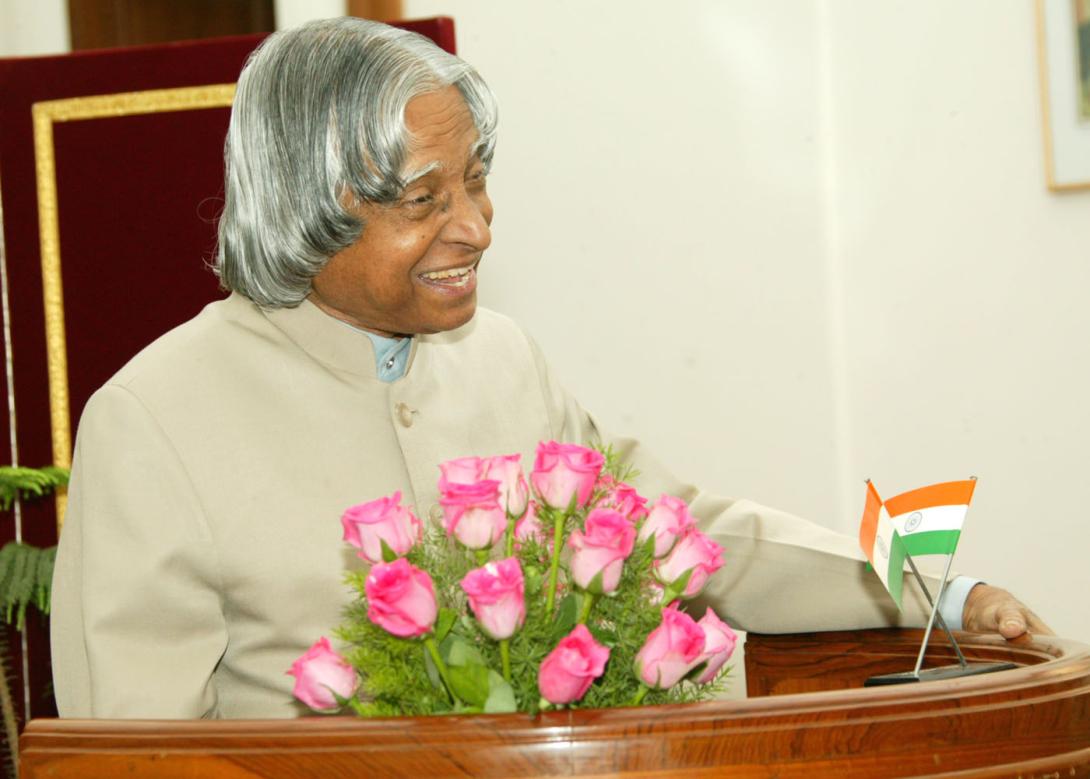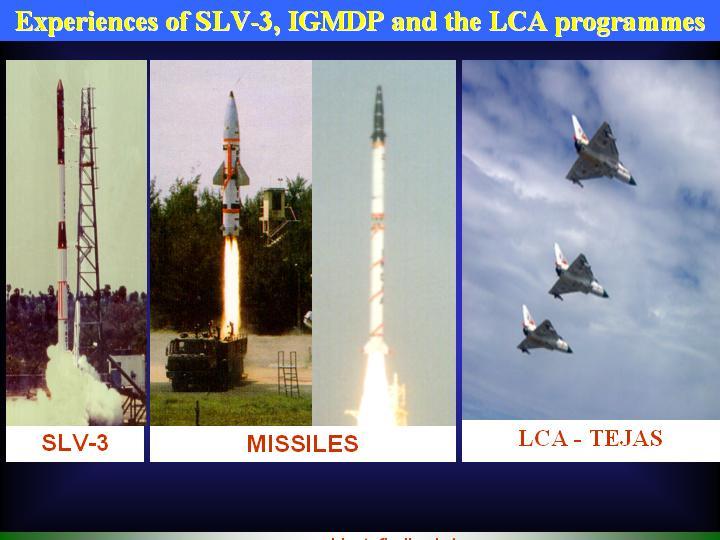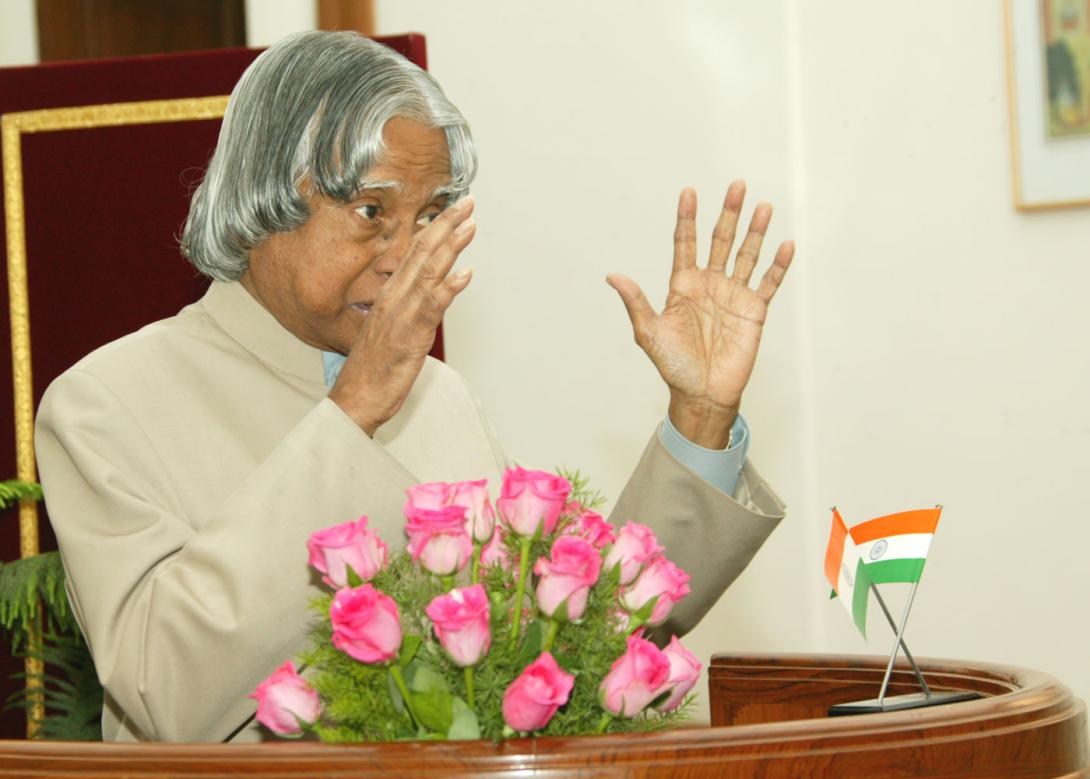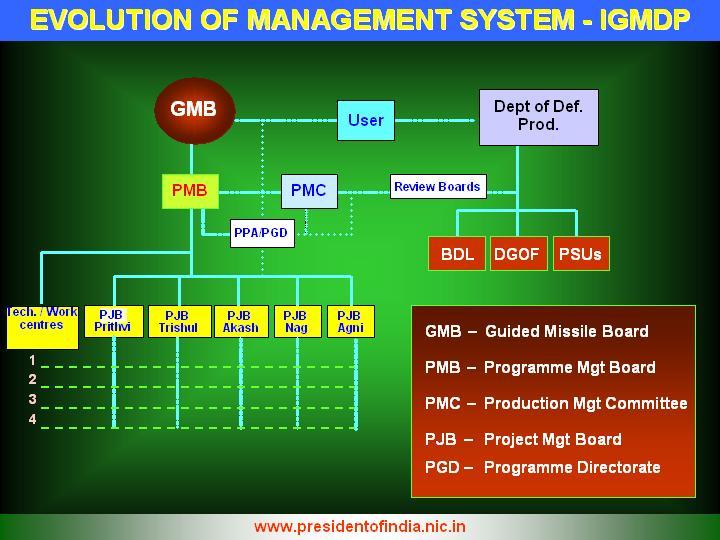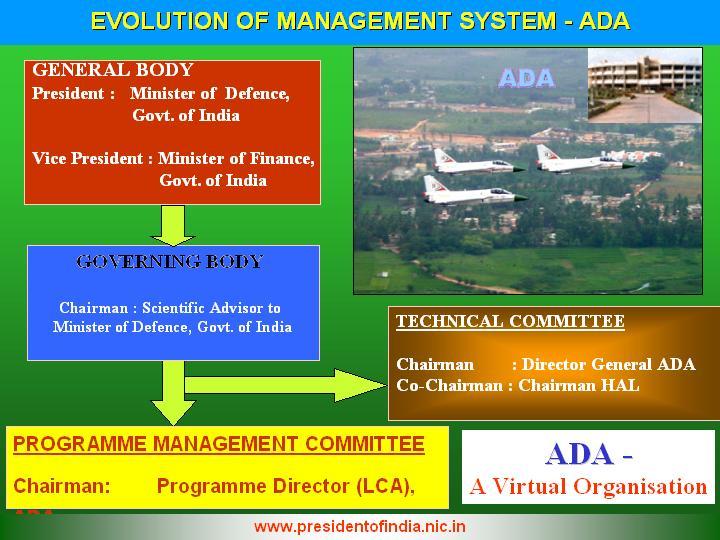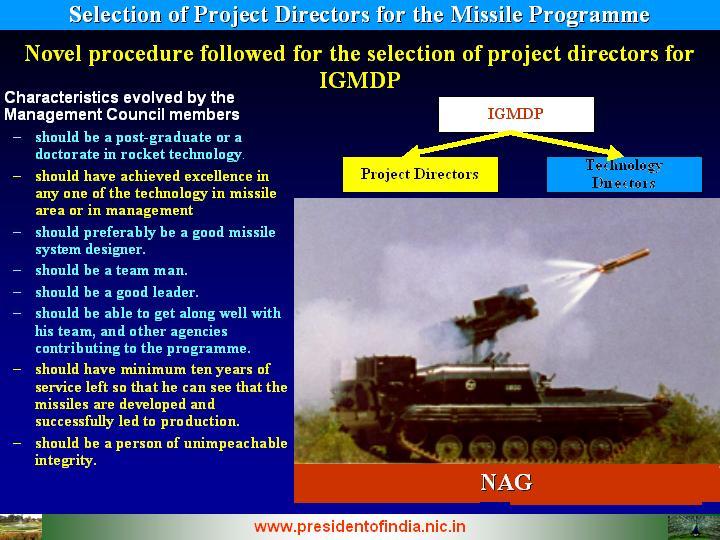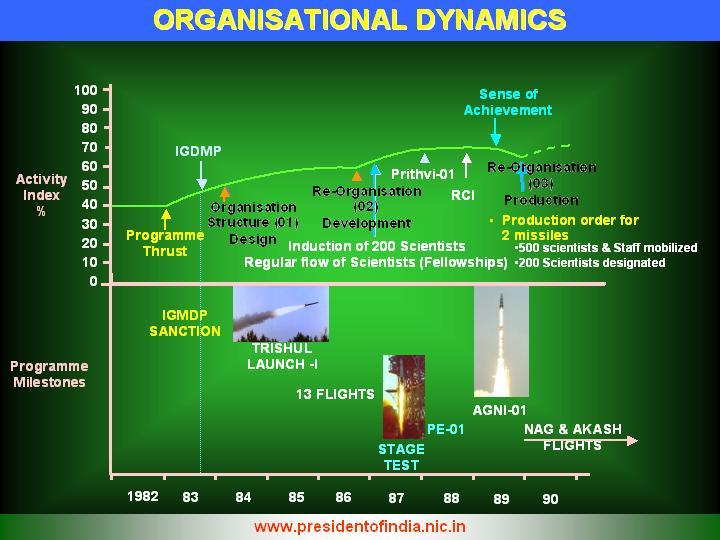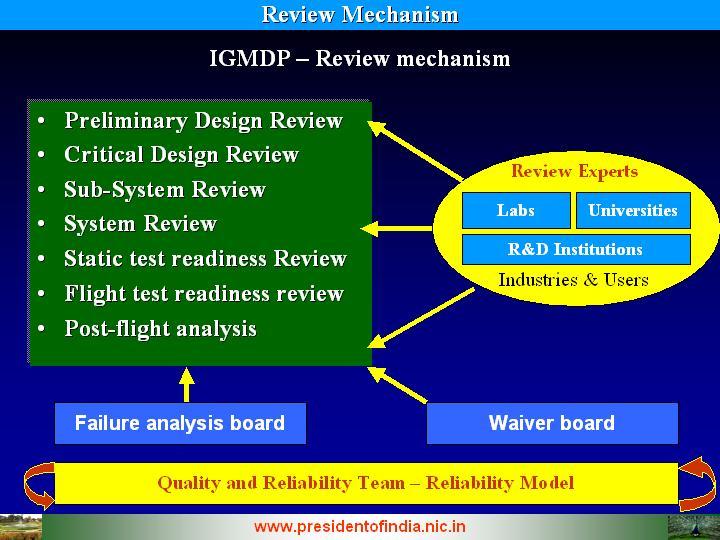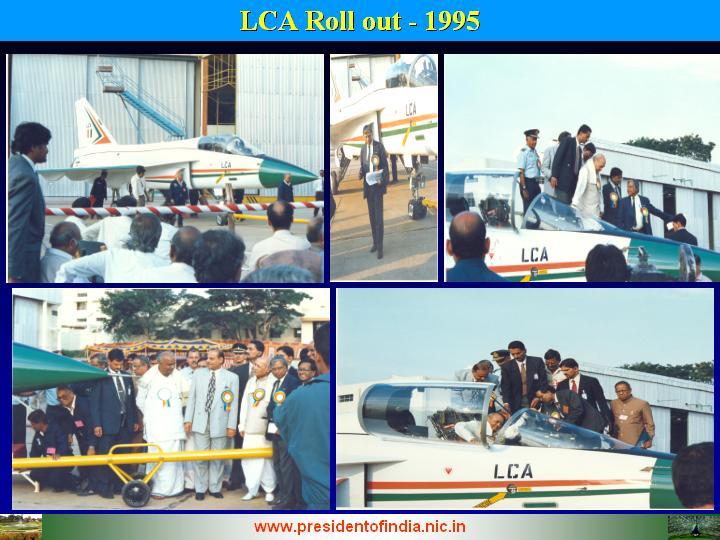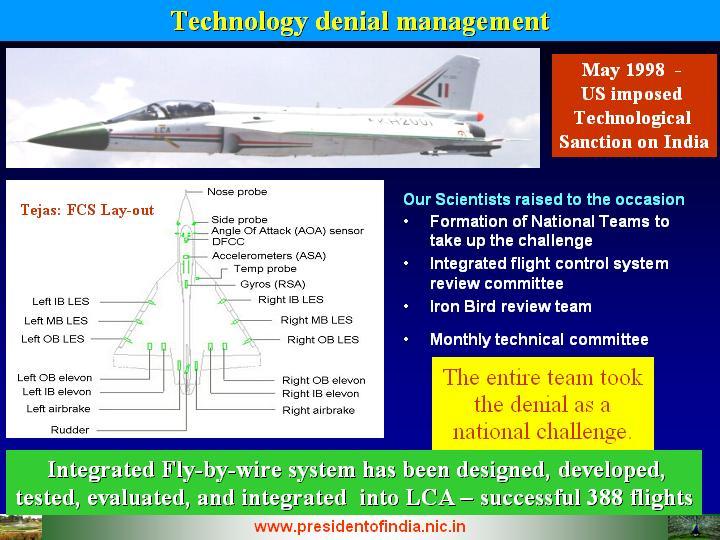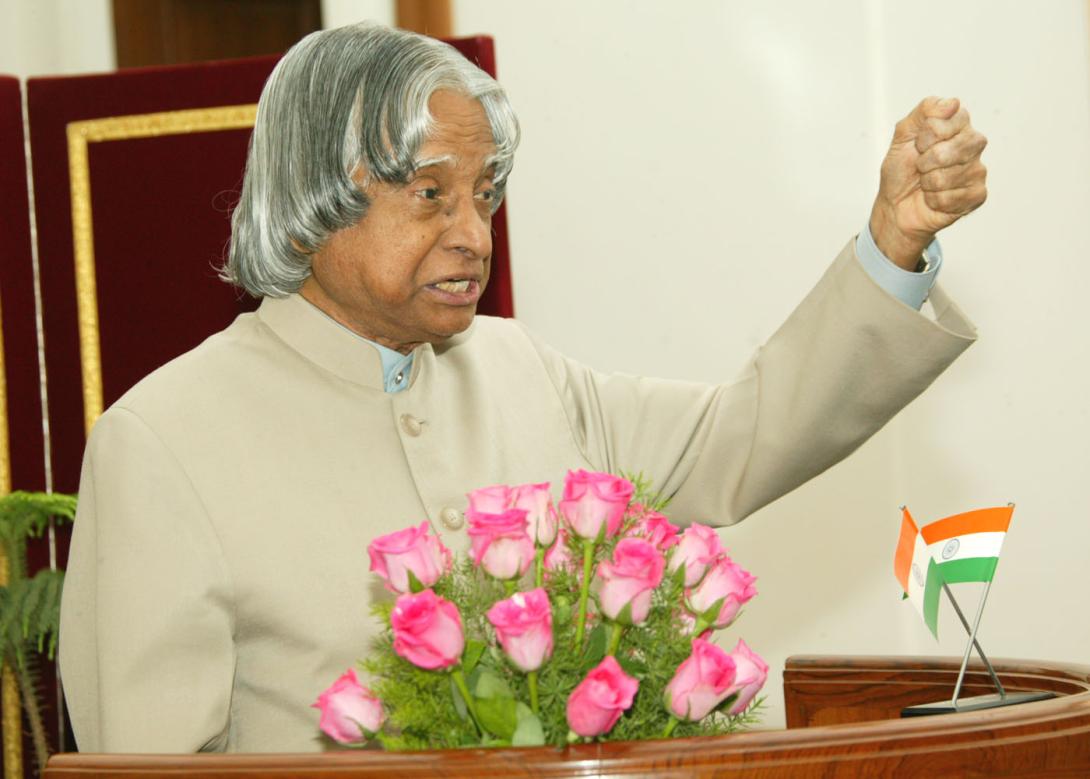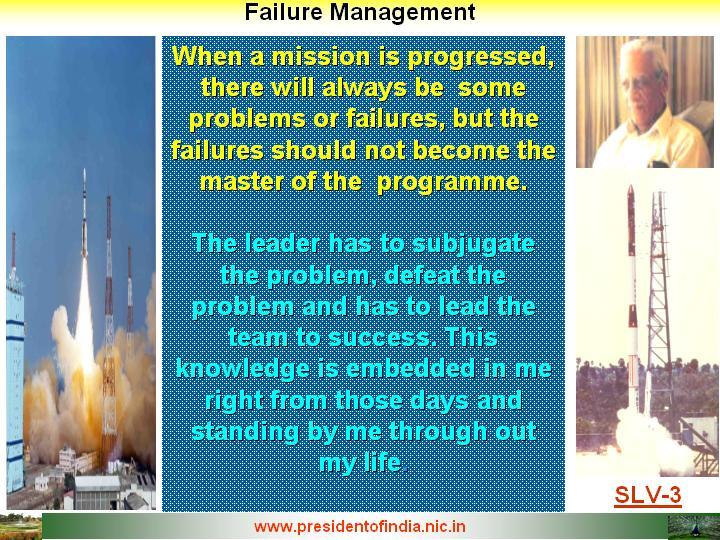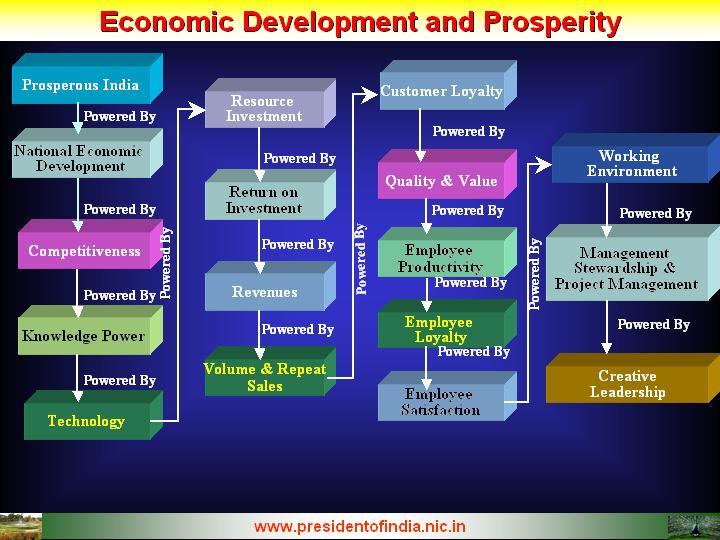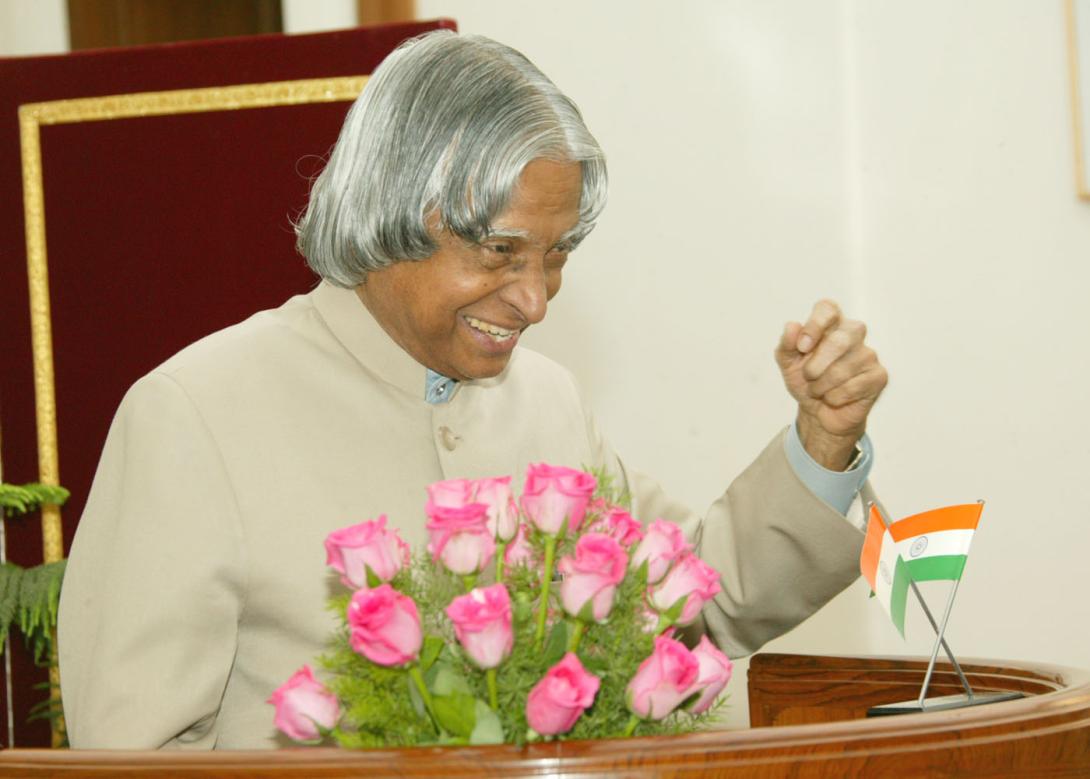Video Conference Address During the Inauguration of Pmi – Asia Pacific Conference 2005
Through Video Conference From New Delhi : 15-04-2005
Some experiences in Project Management
I am delighted to participate in the inauguration of Gyan Lahari - Asia Pacific 2005, Project Management Conference. I am happy to deliver the inaugural address. I extend my greetings to the organizers, project management experts, students of project management programmes, other delegates and distinguished invitees. While executing various national programmes, my team and myself have gone through certain experiences in project management. Based on this, I would like to discuss on the topic “Some experiences in Project Management”.
Some Aspects of the Topic
SLV-3, IGMDP and the LCA programmes have taught me certain critical features of programme management which, I would like to discuss. They are:
a. Igniting the minds for a programme thrust
b. Evolution of management system
c. Choice of programme and project directors
d. Organizational dynamics
e. Review mechanisms for robust management of the programme
f. Importance of recognizing the contribution made by the team members
g. Technology denial management
h. Failure management
i. Ingredients of successful project management
j. Creative leadership
Igniting the minds for programme thrust
All programmes based on national priority must have a clear vision. On 9 February 2005, three Light Combat Aircrafts - Tejas designed developed and produced by Aeronautic Development Agency, Bangalore in partnership with Hindustan Aeronautics Limited, flew as a part of air show demonstration of Aero India 2005, after logging 187 flight hours. This incident made me recall the experience and thoughts; I had while witnessing the Paris Air show along with Dr. V.S. Arunachalam the then scientific advisor to Raksha manthri and Dr. Kota Harinarayana, the then Programme Director, ADA and Dr. K. G. Narayanan, Director ADE in the year 1990. It was a beautiful morning, when we were seeing many of the European, American and Russian fighters crossing the sonic barrier and entering supersonic flight speed.
That time, I wrote a verse
"Let us build our fighter aircraft,
A unique aircraft in its performance,
Which should fly with Indian Flag,
In the Paris Air show".
At that time the Indian Light Combat Aircraft programme was in the drawing board and in the computer aided design stage with many technological options and managerial conflicts. On 9th February 2005, part of the vision has been realized by flying the three LCAs in the Indian Air Show. We have still to work towards flying our aircrafts along with the European, American and Russian fighters in the Paris and other air shows being conducted in different parts of the world. I am sure it will definitely take place. We are very close to such an event. Most important thing is LCA should be inducted into the service and number of squadrons should become operational with LCA.
Evolution of management system
Whenever a project is undertaken by any team it becomes responsible for executing the task to the stated specifications, within the prescribed time and within the prescribed cost. This is true of all projects. To fulfil the responsibility the project has to be provided with adequate resource and the authority to use the resource for meeting the end goals of the Projects. Preferably the project report with time required and cost of the project should come from the people who are responsible to execute the project. Thus, while the missile programme was proposed for around Rs.400 crore in 1983 along with the programme, a three tier management structure was sought with delegated financial, administrative and technical powers for each tier of management. In addition the additional manpower needed by various work centres numbering thousand two hundred including campus recruitment methodology was sought. The program was approved with budget, PERT, additional manpower and management structure after lot of discussion at various levels. Simultaneously, a total management plan was worked out by a internal DRDL team so that a well structured management philosophy and procedure is available for meeting all the eventualities envisaged during the different phases of the programme. This management plan was evolved based on the experience of the management plan derived for SLV-3 and approved by Dr. Brahm Prakash. Sanction of the programme with the funds, the management structure, special delegation of powers and special recruitment process was the unique feature of the missile programme.
I am discussing now, this successful management structure so that it can be used for other projects in the country and elsewhere. The management structure of the missile programme consisted of Guided missile board, Programme management board and the Project management board.
a. The Guided Missile Board laid the policy direction for the total programme, facilitated the provision of support from all external agencies, resolved inter-programme conflicts and provided a long and medium term vision to the project executives. It had the financial power of Rs. 9 crore per item. This board was chaired by the SA to RM with Defence Secretary, Secretary (DP & S), Secretary (Expenditure), the vice chiefs of the three services, FA (DS), CMD (BDL), DGOF and a renowned scientists from National Laboratories were members. Programme Director (IGMDP) was the Member Secretary. Periodicity of meeting was twice in a year. It can be seen that the board consisted of highest authorities from the government, multiple production agencies, all the three users from Armed forces and the development agency.
b. The Programme Management Board was responsible for executing the programme and lead the missile systems into production. It resolved inter-projects conflicts, provided inter/intra project co-ordination and created the infrastructure, facilities and the technologies needed for the programme well ahead of time. This Board had the financial power of Rs. 2 crore per item. This Board was chaired by the Programme Director (IGMDP) who also happened to be Director (DRDL) and Directors of all the participating laboratory, Additional Financial Advisor, key representatives of users, executives of production agency and all the project directors were members. Director (Planning and Resource Management, DRDL) was the Member Secretary. The periodicity of the meeting was three times in a year.
c. The Project Management Board was responsible for executing the project by developing the individual missile system and leading to production. It had the responsibility for developing the technology specially needed by the individual projects. This board had the financial power of Rs. 25 lakh per item. Project Director was the chairman, Project Managers from all participating work centres, user representatives, Deputy financial Advisor (missiles), general managers from missile production agency were members. Member Secretary was nominated by the Project Director. The periodicity of meeting was once in two months.
An important tool of project programme management was the dynamic PERT chart and not the Bar chart. At every project or programme management board meeting, we insisted on the presentation of the latest PERT, based on the present state of progress and asked for the critical path. It should be noted that the critical path becomes different during different phases of the project and also different based on the level at which project is reviewed whether it is Project Management Board, Programme Management Board or the Guided Missile Board.
Selection of Project Directors for the Missile Programme
In June 1983 the Integrated Guided Missile Development Programme was about to be sanctioned. That was the time we had to select the Project Directors for Prithvi, Agni, Akash, Trishul and Nag. In DRDL, at that time many experienced Scientists in Development were competing candidates for this task. Many of them were over fifty. To enable the selection of the most suitable candidate for heading these projects we followed a novel procedure. I called for the meeting of the Management Council of DRDL and the agenda for the meeting was to finalise the criteria required for the selection of the Project Directors. I asked each member of the Management Council to go to the Board and write one characteristics which he considered essential for the selected Project Director. The characteristics mentioned by the members for an effective Project Director were as follows:
a. should be a post-graduate or a doctorate in rocket technology or system engineering.
b. should have achieved excellence in any one of the technology in missile area or in management.
c. should preferably be a good missile system designer.
d. should be a team person.
e. should be a good leader.
f. should be able to get along well with the team, and other agencies contributing to the programme.
g. should have minimum ten years of service left so that the Project Director can see that the missiles are developed and successfully led to production.
h. should be a person of unimpeachable integrity.
When we discussed all the characteristics together, there was convergence among members that the following are the most essential characteristics of the Project Directors: credibility of the person in achieving excellence in one of the technologies or management is the first essential quality. Secondly, Project Director should be young enough to design and develop the missile and lead it to production. Thirdly, the selected candidate should be a person of unimpeachable integrity. With these criteria Scientists of the age group below 40 became the obvious choice for becoming the Project Directors of the Programme. Simultaneously, I nominated the other experienced Senior Scientists as Technology Directors with the responsibility of developing the technologies required by the projects. This created a technological link between the Project and Technology Directors. Project Directors had the sanctioning power which created a healthy relationship between the Project Directors and the Technology Directors.
As an anecdote to this, I would like to mention how we decided on the name of the projects. In a special meeting we invited all the Project Directors and Technology Directors to decide on the names. We put the criteria that the name should be indicative of the performance of the missile systems; it should be simple, there should be an Indian-ness about the name and should be familiar to every one. On this basis the names Agni, Prithvi, Trishul, Akash and Nag were chosen and today these names have become household names in many places. People at large, common man and even high school students are aware of these names and know what type of missiles these names indicate.
Organizational Dynamics
The unique feature of the Integrated Guided Missile Development Programme was that it included the funds required for limited series production of the missile systems. The programme, thus, had four different phases viz., the design phase, development of sub-system and systems, trial and evaluation including flight trials and productionisation of the systems. The laboratories executing the programme had to be appropriately organized for managing the load of the different phases of the programme. Realizing this feature initially in 1983, DRDL was reorganized to undertake the complex Integrated Missile Development Programme and execute the first phase viz. the design phase. The activity level was being continuously monitored to see the result of this reorganization. Initially, the activity index was around 40% which rose to nearly 60% during the period 1983-86. By this time, the laboratory has entered into the second phase, development of sub systems and systems and conduct of flight tests in some cases. Since, the activity index showed saturation characteristics and started slightly drooping, we had to carry out the second reorganization in 1986 to improve the activity index for that period. With this reorganization the activity index rose to nearly 70% by the year 1998 when flight test of Trishul, Prithvi and Agni were all carried out. Then there was again a tendency for the activity index curve to droop which led to the third reorganization in late 1989 while the programme entered the production phase and orders for two missiles systems had been placed on the production agency and Nag and Akash system were ready for flight tests. The message which I would like to convey is that the projects, the programme managers and the work centers must be sensitive to the organizational dynamics and organizational output of the different phases of the programme and plan reorganization well in advance so that the organization maximizes its output.
Review Mechanism
With the sanction of the missile programme in 1983, we had created an institutional mechanism of robust review of all stages of the projects. These reviews included preliminary design review, critical design review, sub-system review, system review, static test readiness review, flight test readiness review and post-flight analysis. The important feature of the review mechanism was the review experts were drawn from different specialization working in different laboratories and universities spread in different parts of the country. Any expert available in the field was sought by the project as a review member which enabled them to get the collective wisdom of specialists on technical issues. Review recommendations were executed faithfully by the project team in a time bound manner. In addition to this, failure analysis board, waiver board were also created for undertaking the review and corrective action for certain classes of failure and authorizing waivers in marginal cases. The quality and reliability team was asked to work out a reliability model of the system under test and present it before flight test readiness review so that the flight test authorization board can take a considered view on the desirability of proceeding for the test in case the reliability margin is low. The reliability model was constantly updated based on the predicted reliability and the performance of the system during the flight test. I always found that the confidence of the scientists and the team became very high if the review was carried out objectively. Also hidden problems were invariably brought out during the review which became a valuable input to the programme.
Importance of acknowledging the contribution made by the Team Members
I would like to recall an event which took place in 1995. We were having the LCA roll out in the HAL Bangalore campus. To my surprise I found that the most important person who was the life line of the programme was sitting in the first row. I did not know why he was sitting there. At that stage during my welcome address I started describing about Dr. Kota Harinarayana’s contribution in the development of the LCA. I called him to the dais and gave my chair. Immediately they brought another chair for him for being seated in the dais. There was a big cheer from the crowd since all of them acknowledged the contribution of Dr. Kota Harinarayana for the programme.
At this stage I would like to describe my experience while working on the design project of the fourth stage Apogee motor. During Dr. Sarabhai’s time, Dr. Muthunayagam was the Design Project Leader for the third stage. Dr. M.R. Kurup was the Design Project Leader for the second stage. Dr. Gawarikar was the Design Project Leader for the first stage. Dr. Gupta was the Design Project Leader for the guidance system. Prof U.R. Rao was the Design Project Leader for the Rohini satellite. I was the Design Project Leader for the fourth stage and the heat shield. The review was carried out by Dr. Vikram Sarabhai. He normally invites for such reviews experts from academic institutions since it was a design phase. For this review he had invited Prof I.G. Sharma, a well known Guidance and Control System and Simulation Expert, Prof Narashima aerodynamic design and atmospheric sciences, Prof Mahapatra, radar system and Prof K.A.V. Pandalai, aerospace structure. Every project leader gave a presentation on the progress and problems relating to their task. Finally when my turn came, I gave a three minute presentation on the overall status of the project. Later, I asked Shri Sudhakar, System Designer, Shri Sathya, Composite Products Engineer, Shri Abdul Masjid, aerospace mechanism Engineer and Shri Namboodri, Rocket Motor Designer to give short presentation on the progress of sub-system design. When my team completed the presentation, discussion time came. Many technical and managerial questions were asked. I answered. At that stage there was a question from an experienced scientist. Mr. Kalam, I saw the presentation from your Team one after the other. What you have done? How to answer this question? I was framing the answer. Dr. Vikram Sarabhai said Mr. so and so what Kalam did is indeed project management. That is how I would like to hear from the people who have actually carried out the task. Friends, project management demands that the project team must be able to get things done from different people and different institutions. People who contribute to the project should know that they are very important for the project, and they are remembered.
Technology denial management
In the year 1992, LCA team decided to go for Digital-Fly-by-Wire Control System (FCS) for the Combat Aircraft as it is an unstable aircraft. At that time, the country did not have the experience in developing FCS. The only two countries who had the experience were France and US. The French company (Dassaut System) had expertise in Hybrid systems whereas our need was an all Digital-Fly-by-Wire. Hence, it was thought appropriate to have a US partner who has the capability in design, development and integration of FCS on fighter aircraft. There were three candidates, General Electric Control which later became LMCS (now called BAe systems), Lear Astronics and Bendix. Finally, we chose LMCS for the contract since they had the experience in designing FCS for F-16 Aircraft. Joint Team for design and development of the FCS was formed with ADE (DRDO Labs) and LMCS. The work share between Indian team and LMCS team was identified. Evolution of the SRS was the joint effort. The prototype flight control computer was to be done by ADE. Total system integration was the joint responsibility. Flight certification was to be provided by LMCS.
The contract progressed though a bit slowly between 1992-98. Then, as you all are aware, India carried out its nuclear test on 11th May 1998. As soon as this event occurred the American Government imposed technological sanction. Due to the sanction, LMCS broke the contract and retained all the Indian equipment, software and the technical information which were in their premises.
This was definitely a shock for the Indian team. Immediately, I called for a meeting of Directors of ADA, NAL, ADE, CAIR, HAL, National Flight Test Centre, Prof I.G. Sharma, a renowned control system specialist, Prof Goshal, a noted digital control system expert and guidance and control specialists from DRDL and ISRO. The FCS team explained to these members the situation arising out of the unilateral termination of contract by LMCS. We had a full day discussion on the methodology which now need to be followed by which we can successfully complete the development of digital fly wire system and fly the LCA. The team after prolonged deliberations gave a structured method by which the development can be completed and the system can be certified for flight trials. They also mentioned that they will support the programme in whatever capacity they have to work with the ADE and ADA teams.
Based on the recommendations of the specialists we immediately strengthened the ADE software team with additional ten experienced software engineers from ADA. ADA was given the responsibility of verification and validation of software. Integrated flight control system review committee was constituted with Director (ADE) as Chairman and PGD (ADA) as Co-chair to support development and resolve all the conflicts arising between Control Law Team, Iron Bird, Software, Hardware and simulation. This team met once in a week and brought out all the issues arising in different work centres and solutions were found. In addition, an Iron Bird review team was formed with Project Director Flight Control System as Chairman with members from HAL, ADA, ADE, certification agency (CEMILAC) and Test Pilots from National Flight Test Centre as Members. This team also met every week and resolved all the problems arising in the development and Test on Iron Bird. We also introduced participation of certification agency (CEMILAC) and inspection agency (CRI) in all these reviews. The aim was to see that any problem in any system is brought into focus at the earliest so that the solution can be found. In addition, we made it a point to have a special agenda in the monthly technical committee meeting on the development of integrated flight control system wherein Director (ADE), Director (NAL), Director (National Flight Test Centre), General Manager (HAL) presented the progress and problems. The confidence building took place by intensifying the tests. For example informal Iron Bird test was carried out over thousand hours and the formal Iron Bird test was conducted over hundred and fifty hours. Similarly, Pilot flew the simulator for more than two thousand hours. Thus, what we missed from the foreign partner, we compensated by enhancing the critical design review and increasing the test time to ensure safe man rated design of the integrated flight control system.
The entire team took the denial as a national challenge. They said if it is going to take three years we will do it in two years. If it is going to take twenty million dollars we will do it in ten million dollars. Our working hours was not eight hours. We will work twenty four hours a day and complete the task. That is the time I realized the power of Indian Scientific Community, and the power of our country. I realized that no country can dominate us by imposing technological sanction or economic sanction. Power of scientific team will defeat the petty designs of any nation. Today I can proudly say that our scientists have designed, developed, tested, evaluated, and integrated the integrated flight control system in the LCA which has logged more than 388 trouble free flight sorties in three different aircrafts. The challenge of the development is that the aircraft of this class is being designed for the first time, we introduced the state-of-the-art digital fly by wire technology in the very first prototype which is unstable. We on our own developed the final hardware and software required for testing and evaluation of the control system in the aircraft, after the foreign partner leaves the scene and our own certification team which had no experience in certifying fly by wire aircraft, gains confidence and certifies the aircraft as flight worthy. Above all, the pilots who have never flown a prototype which is unstable with a fly by wire system confidently flew the aircrafts based on their flying experience in the simulator and the Iron Bird. Honest self assessment, identification of area of uncertainty and all out effort to solve the problem was an important aspect of this programme. Integrating strength of industry, R&D Labs, Academic and Air force helped to achieve, what was perceived to be an impossible task. This is a demonstration of the Indian will that ‘we will win’.
Failure Management
Two and a half decades ago while I was working at ISRO, I had the best of education which won't come from any university. I will narrate that incident. I was given a task by Prof. Satish Dhawan the then Chairman, ISRO to develop the first satellite launch vehicle SLV-3, to put ROHINI Satellite in orbit. This was one of the largest high technology space programmes undertaken in 1973. The whole space technology community, men and women, were geared up for this task. Thousands of scientists, engineers and technicians worked resulting in the realization of the first SLV-3 launch on 10th August 1979. SLV-3 took off in the early hours and the first stage worked beautifully. But the mission could not achieve its objectives, as the control system in 2nd stage malfunctioned. There was a press conference at Sriharikota, after the event. Prof. Dhawan took me to the press conference. And there he announced that he takes responsibility for not achieving the mission, even though I was the project director and the mission director. When we launched SLV-3 on 18th July 1980, successfully injecting the Rohini Satellite in to the orbit, again there was a press conference and Prof. Dhawan put me in the front to share the success story with the press. What we learn from this event is that the leader gives the credit for success to those who worked for it, and leader absorbs and owns the responsibility for the failure. This is the leadership. The scientific community in India has the fortune to work with such leaders, which resulted in many accomplishments. This success generated great happiness among all my team members. This is an important lesson for all project managers.
Economic development and prosperity
Since the audience may consist of members from the industry, corporate institutions and government establishments and students of project management, I would like to talk to you about the growth of the economic development and prosperity, in which project management is one of the components.
- Nations Economic development is powered by competitiveness.
- The competitiveness is powered by knowledge power.
- The knowledge power is powered by Technology and innovation.
- The Technology and innovation is powered by resource investment.
- The Resource investment is powered by revenue and return on Investment.
- The Revenue is powered by Volume and repeat sales through customer loyalty.
- The customer loyalty is powered by Quality and value of products.
- Quality and value of products is powered by Employee Productivity and innovation.
- The Employee Productivity is powered by Employee Loyalty, employee satisfaction and working environment.
- The Working Environment is powered by management stewardship and sound project management.
- Management stewardship is powered by Creative leadership.
Conclusion: Creative Leadership
For success in all projects we need creative leaders. Creative leadership means exercising the vision to change the traditional role from the commander to the coach, manager to mentor, from director to delegator and from one who demands respect to one who facilitates self respect. I am sure all the institutions and the future aspiring institutions are spearheaded by creative leadership. For a prosperous and developed India, the important thrust will be on the growth in the number of creative leaders and innovative organisations who can create wealth through dedicated project management.
My best wishes to all the participants of this conference success in the evolution of project management plan and its execution leading to economic prosperity of the nation.
May God bless you.
Question and Answer Session
1. Prahlada, DRDL, Hyderabad
What would you like to suggest for de-stressing the life of Project Managers in the ever increasing Global competitive world? He has lost his smile!
Ans. Innovation must become your friend to bring back the smile.
2. Mr. Raju Mosa, Hyderabad
Dear President, What are the integration management challenges and some cases of resolution in defense / space projects? My understanding: Generally defense / space projects are done in small units in order to maintain confidentiality. The projects could be a combination of hardware and software components. What are the typical challenges in integration?
Ans. In the modern system like space launch vehicle, fighter aircraft and missile system has nearly 50% to 60% software component. Integration challenge can be mat through Digital simulation programme and Hardware in loop simulation.
3. Ms. Lakshmi Gopal, Bangalore
India has made many advances in science and technology but still when there are natural disasters & other disasters like train accidents, loss of life is very high. Why do you think we are not able to use technology effectively to predict & warn people in advance?
Ans. Disaster management is a specialized subject. The government has created a special task force on disaster management. They identify the places where specialist sup[port for disaster management is available in the country in normal time. This information is used to speedup the relief operation.
4. Mr. Srinivasu Satti, Hyderabad Parents of Indian children should be able to guide their kids in the present day to more of broad based educational streams than stereo typed technology streams. Thanks to India riding on the opportunity wave globally on human resources, how and when will the average Indian parent comes out of the typical ‘beating the competition’ kind of mode to much better broad based development of their kids. Now the parents should know there are more opportunities available and there is no need mad rush on competition.
Ans. All parents are anxious to place their children in a economically sound profession. Today in the country numbers of placement consultancy institutions are coming. This will probably enable the parents to look for broad base development of the children.
5. Saiprasad Josyula, PMP, Hyderabad
Almost all the Projects undertaken by our successive Governments suffer Cost and Time overruns, thereby severely impacting the meager public funds of our Country. This not only results in a delay in creating assets, but at the same time causes drain on the exchequer which results in reduced spending by Government on vital needs of our people. Could you as a pioneer, articulate the importance of Good Project governance to the Government and bring accountability on projects undertaken and also throw some light on any efforts in this direction?
Ans. Propagation of successful programmes is the continuous feedback to all project managers. I have been suggesting that all government project must be executed as mission mode projects.
6. Karthik Jagannathan, Hyderabad
Project Management in IT is more about people management. So is the case in governments too. If in IT we need MBA’s and PhD’s to manage people and resources – when and how can we see this fundamental shift in governments?
Ans. This is already taking place in many of our institutions.
7. Madhu Angara, Hyderabad
With IT industry taking the driver’s seat in the economic boom world wide and especially in India, what are the initiatives of the government to manage the digital divide amongst a predominantly rural population? What are the steps being taken to maintain or sustain the Indian IT LEADERSHIP?
Ans. It is not true. IT alone cannot bring a boom. IT combines with other domains brings value addition and wealth generation. Some of the areas are Bioinformatics, Tele-education, Tele-medicine, e-Governance, e-commerce, e-business; bio-nano-info technologies will together bring the boom to any nation. Apart from this, knowledge products arising out of IT will also be a value added wealth generator. For bridging the rural – urban divide – we need to work on language neutral operating systems and application servers.
8. Mr. Cathryn Chee, Singapore
I understand currently India has a very good combination of top-three federal positions: The president (a great Project Manager himself); The Prime Minister and the Finance Minister. There were significant progresses made in many areas. What do you think are the opportunities and the impediments for a fast growth rate in Infrastructure projects in India, to match world-class infrastructure like that of my country Singapore that may also eventually help the Asia Pacific region to grow?.
Ans: There is definitely a need for developing world class infrastructure in India. We have large programmes which are already launched for building long distance road connectivity. Similarly, We have a programme called Providing Urban Amenities in Rural Areas (PURA) which will specifically address the problem of providing infrastructure in the rural sector and bring the connectivity to the urban areas.
9. Ms. Patty Wong, Vice President of PMI, Hong Kong
What would be helpful to foster closer relationship among chapters with the Asia Pacific Region? In what way the PMI regional office is able to play a leading role on this issue?
Ans: PMI must arrange periodic presentation of successful project managers who have implemented complex projects. Sharing of experiences of success and failure between chapters will enable closer relationship between them.
10. Mr. Khuram Rahat, President – PMI Pakistan
Within SAARC countries can we bring in the need of Professional Project Management Practices at core government and private sectors by evolving mechanism relating to education, certification Processes and best practices and share within Government and private sectors. Also we should make sure that such knowledge and best practices reach cost effectively to the individuals across countries especially developing countries. Can the president express his view on this? And will there be any actions that we can expect at ministry level?
Ans: I agree that we should be able to disseminate best practices on Project Management to different agencies in the country. However, I do not think that it should be done by the Government. This should be taken up by institutions like PMI in promoting the practices in different areas by enabling the personnel who have qualified to run projects. In this connection, I would like the SARRC Countries to share their core-competence in different areas. For example, some country may have competence in production of cotton. Another country may have competence in converting into yarn. Third country may have competence in making it into cloth. Fourth country may have competence in garment production and marketing. If we share the competence of different countries, it will become a win-win situation for all.
11. Shri Sridhar Rao, Chennai
Project Management as a domain is fast growing worldwide. Projects and Programs take a big share of investments in every economy. As a nation with a vision of becoming a developed country by 2020 what is our strategy on this core skill/knowledge development? Many of our central /state departments are functionally aligned with limited project focus. What is your message to us towards the needed transformation and project focus across the needed sectors? How do we bring a gross root level awareness about the professional project management and sharing of best practices across domains?
Ans: We have a road map for implementing the developed India mission. We have to work in five areas simultaneously on mission mode. They are (1) agriculture and agro processing, (2) Education and Healthcare (3) Information and Communication Technologies (4) Infrastructure including transportation and quality power and (5) critical technologies. In many areas the project focus has already commenced. I am also advocating implementing all these tasks on a mission mode basis.

